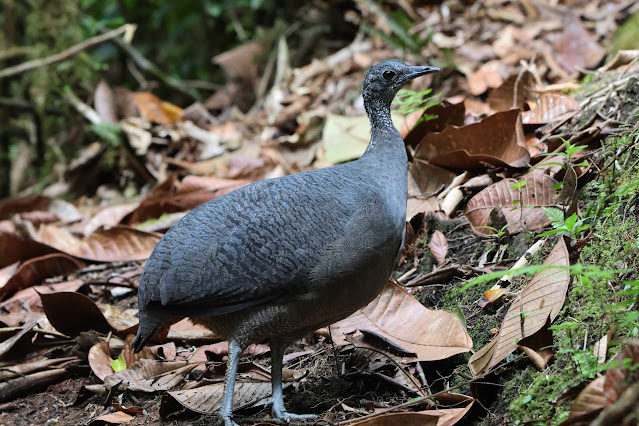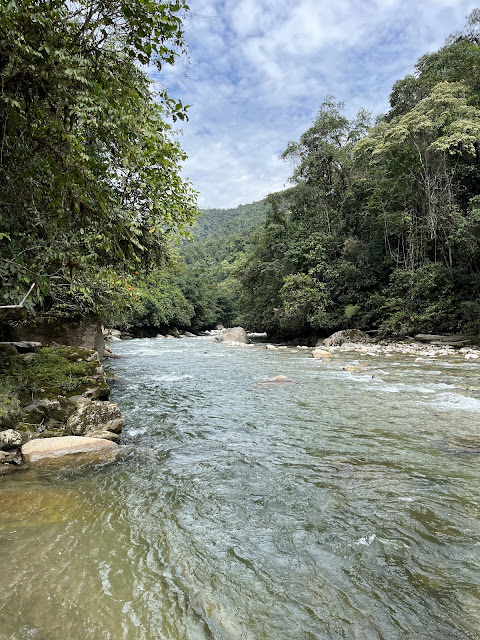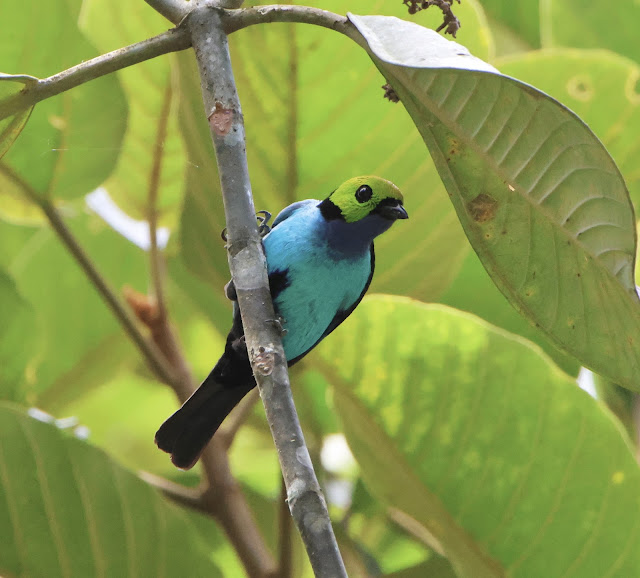The Copalinga Lodge has been around for some 20 years, and was created mainly for birders. Originally owned and built by a Belgian couple who sold to the Jocotoco Foundation, who now manages it. After we were finally in the country, I completed my plans to visit a few areas on the east side of the Andes, Copalinga being one of them. I’d been reading bird reports from this lodge for years, so knew it to be a place I wanted to visit some day. Not knowing what to expect, I had Hernan take us there prior to getting to the hotel, but the gate was locked. So I climbed through the barb wire fence and went up to the lodge area, knocked on a few doors, but no one was around. After all, it was New Year’s Day……
At 07:00 the next day we took a taxi there, and the driver showed us another, smaller gate which was open, so we paid him the $3.00 and went in. In the restaurant area we met Walter who seemed glad we were there. He did not speak English so, after our experience at Tapachilaca I felt I ought to show him the reservation notice I had on my phone. He then asked what time we wanted to eat, and we told him 10:00, so I figured there would be no mis communication this time. The cook later came out and asked us the same thing, and we changed our minds and made it 11:00.
Walter came out with us to the immediate lodge grounds and showed us a few birds. We hung around there for about a half hour before embarking on the trails.
THIS BRIDGE HAS SEEN BETTER DAYS. ROSIE WENT FIRST TO TEST IT
He had shown us where a few “stake-out” birds were on the map, which I suspected we were there a little late for, and such it proved to be. We heard many birds but were not able to ID many at all. Plus, all the trails were steep in parts, which was a challenge for us. The best bird by far we found was the Gray Tinnamou. I strongly suspect this bird is one (s?) that they feed here as he allowed us to get within 12 feet of him. I think normally they are very shy.
GRAY TINNAMOU
By the time we were to eat we returned to the restaurant. I asked the cook if she could put out some bananas on the feeders, which she did. Shortly thereafter I spied a monkey…. and then another…. and then another. It turned out that they were also waiting for bananas as well. In short order one came down and swiped two of them and dashed back into the trees. In a minute the other 2 bananas were gone also. No wonder they don’t feed the tanagers anymore! It was hard to estimate, but I think there were a dozen of them or so.
CAPUCHIN MONKEY
One young one stayed near the feeding station for a good half hour after the rest left, actually sobbing because he did not get any banana.
HERE IS THE YOUNG PUNK WHO DID NOT GET A BANANA
During our meal I noticed a movement out of the corner of my eye, which turned out to be a Black Agouti who came for cracked corn.
BLACK AGOUTI
After lunch we walked down the road where it was flat and mostly shady. The birds were still fairly active and a cloud cover was still helping us, somewhat. Not far down the road was a house that had Crested Oropendula nests hanging from a tree almost over their roof, and a few of them were buzzing around. As big as they are you’d think they would be easy to photograph, but I’ve not obtained one to my satisfaction as yet.
CRESTED OROPENDULA
We soon found a path down to the Bombuscara River. It was a nice place to sit for a few minutes. I looked up and down stream for dippers, but had no success.
BOMBUSCARA RIVER
BOMBUSCARA RIVER
One beautiful bird we did see was the Bay Headed Tanager, which I hope to eventually get a picture of. As it was getting hot and the sun started beating down on us, we decided to turn around, and shortly thereafter we found my number ONE target bird - a Paradise Tanager. Seeing one in this location was virtually garenteed, so it was just a matter of time.
PARADISE TANAGER
THE HOLES IN THESE FLOWERS WERE MADE BY BIRDS CALLED “FLOWER-PIERCERS.” THEY DO THIS TO RETRIEVE THE SWEET POLLEN INSIDE
When we reached the lodge Rosie decided to hang out in the restaurant while I waited around outside for a certain hummer to come to the flowers. We had about an hour to wait until Walter would appear and take us to feed the Gray Tinnamou, so it was a good way for me to kill time. The hummer never did show up, but there were plenty of others to occupy my time.
BLUE-GRAY TANAGER
WEDGE-BILLED WOODCREEPER. THOSE END “FEATHERS” ARE USED AS A PROP
SPARKLING VIOLETEAR
SPECKLED CHACHALACA
TROPICAL KINGBIRD
Walter arrived on cue, and we left Rosie behind as she had had enough hiking for the day. It was great to bird with Walter as he knew the birds and their songs. He would pick one out after another. Thanks to him I got my lifer Masked Tanager, Golden-headed Manakin and Orange-eared Tanager. We heard and saw a few others I had overlooked earlier. Well, the Tinnamou was a no show, so it is good that we saw it earlier. I ended up with 54 species for the day, a few of which were lifers.
Walter called a taxi for us who was there speedily, such that we had to go into the restaurant and hastily pack our stuff. So it was a good day, even though I missed a number of expected birds. In hindsight, I neglected to take any pics of the lodge/restaurant area.















We visited Copalina in 2022. We were disappointed that the monkeys had taken over and discouraged the normal lot of birds from coming to feed. That said, we still had a great time on the grounds and in the surrounding area. I wonder if soaking the fruit in very hot pepper sauce might not discourage the monkeys? I've heard birds don't suffer the burning sensation that mammals get.
ReplyDeleteSorry, Copalinga not Copalina.
Delete